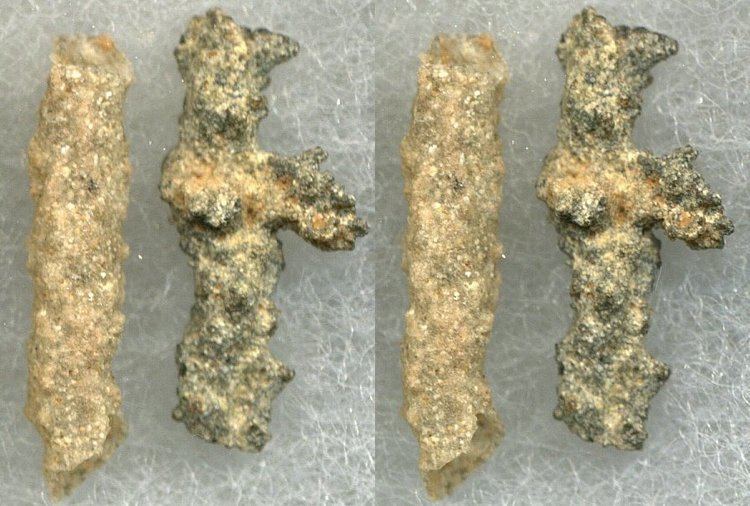 | ||
Fulgurites (from the Latin fulgur, meaning "lightning") are classified generically as a variety of the mineraloid lechatelierite, although their absolute chemical composition is dependent on the physical and chemical properties of target material affected by the discharge of cloud-ground lightning. They are commonly hollow and/or branching assemblages of glassy, protocrystalline, and heterogeneously microcrystalline tubes, crusts, slags, vesicular masses, and clusters of refractory materials that often form during the discharge phase of lightning strikes propagating into silica-rich quartzose sand, mixed soil, clay, caliche and other carbonate-rich sediments. Colloquially, they have been referred to as petrified lightning. Fulgurites are homologous to Lichtenberg figures, which are the branching patterns produced on surfaces of insulators during dielectric breakdown by high-voltage discharges, such as lightning.
Contents
Description
Fulgurites are formed when lightning melts silica or other common conductive and semiconductive minerals and substrates, fusing, vitrifying, oxidizing and reducing mineral grains and organic compounds; the fulgurite mass is the rapidly quenched end-product. The temperature peak within a lightning channel, however, is known to exceed 30,000 K, with sufficient pressure to produce planar deformation features, or "shock lamellae" in SiO2 polymorphs. It is assumed that the process of forming a fulgurite occurs over a timespan of the order of a single second, following the termination of the return stroke sequence, and leaves direct evidence of the dissipation path and its dispersion over the surface or into the earth. Artificial fulgurites can also be produced when the controlled arcing of electricity into a fusable medium. This has been documented in cases of downed high voltage power lines; current was discharged into the ground, producing blue fulgurite-like lechatelierites, colored by copper from the power line.
The color of fulgurites varies widely, depending on composition and chemical impurities. It can range from black or tan, to green, blue, metallic blue-grey, or a translucent white. More colorful variants are usually synthetic and reflect incorporation of synthetic materials. The interior of Type I (sand) fulgurites normally is very smooth or lined with fine bubbles, while other types are often both vesicular and dense or porous and scoria-like; their exteriors generally can be coated with rough sedimentary particles and can be porous, smooth, or structurally complex. Fulgurites display some degree of self-similarity and structural scale invariance as a macroscopic or microscopic network of root-like branches. Fulgurites formed in sand or loose soil are mechanically fragile, making the field collection of large specimens difficult.
The primary SiO2 phase in fulgurites is lechatelierite, a silica glass. Because their groundmass is generally amorphous in structure, fulgurites are classified as mineraloids.
Fulgurites can exceed tens of centimeters in diameter and can penetrate deep into the subsoil, sometimes occurring as far as 15 m (49 ft) below the surface that was struck, but may form directly on appropriate sedimentary surfaces. One of the longest fulgurites to have been found in modern times was a little over 4.9 m (16 ft) in length, and was found in northern Florida. The Yale University Peabody Museum of Natural History displays one of the longest known preserved fulgurites, approximately 4 m (13 ft) in length. Charles Darwin in The Voyage of the Beagle recorded that tubes such as these found in Drigg, Cumberland, UK reached a length of 9.1 m (30 ft). The Winans Lake fulgurite[s] (Winans Lake, Livingston County, Michigan), extended discontinuously throughout a 30 m range, and arguably includes the largest reported fulgurite mass ever recovered and described - its largest section extending approximately 16 ft (4.88 m) in length by 1 ft in diameter (30 cm).
Classification
Fulgurites have been classified by Pasek et al. (2012) into five types related to the type of sediment in which the fulgurite formed, as follows:
Place in planetary processes and the geologic record
Many observations have been made in fulgurites of high-pressure, high-temperature materials more commonly assumed to be the exclusive to meteoritic sources, products of asteroid impacts, comet airbursts, or cosmic dust influx. Such materials - as a suite - formerly considered to be unique to hypervelocity impacts, have been identified in fulgurites, including highly reduced silicon-metal alloys (silicides), the fullerene allotropes C60 (buckminsterfullerene) and C70, as well as high-pressure polymorphs of SiO2, in fulgurites.
Reduced phosphorus as phosphides and phosphites have been identified through quantitative analyses of a representative sample of 10 fulgurites recovered from most continents, in the form of schreibersite (Fe3P, (Fe,Ni)3P) - terrestrially extremely rare, but common on meteorites, comets, interplanetary dust, and some planetary bodies - and TiP, which is unique to fulgurites.
Fulgurites are, with the analysis of paleomagnetic (LIRM, or Lightning-induced remanent magnetism) anomaly, primary sources for environmental information produced by the study of paleolightning in paleoclimatology and atmospheric sciences. For instance, the fact that fulgurites are abundant in the central Sahara Desert, where thunderstorm activity is very rare, demonstrates that thunderstorms were once more frequent in that region, and as such, their spatial distributions guide reconstruction of convection and precipitation patterns, while their pores enclose and preserve samples of the ancient atmosphere in which they formed.
In material culture
A fulgurite was found within the contents of the ash altar at the temple (hieron) of Lykaian Zeus at Mount Lykaion in Greece. It may be associated with ritual activity performed there.
Fulgurites are appreciated by many for their value as permanent tangible evidence of transient lightning strikes. Fulgurites also are popular among hobbyists and collectors of natural specimens.
